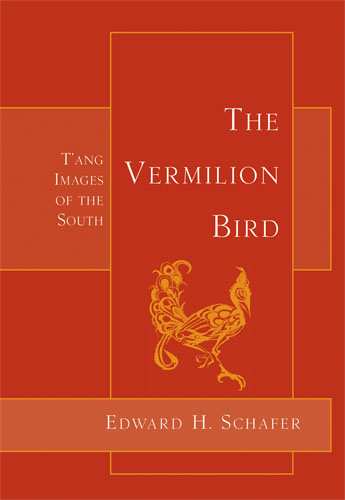
The Vermilion Bird
T'ang Images of the South
by Edward H. Schafer
In the seventh century the great T'ang nation was obliged to reconquer the southernmost portion of what had been considered Chinese territory for many centuries. The region had in fact remained largely an unassimilated wilderness, whose heavily forested marshes—monsoon lands with fringes of the true tropics—corresponded roughly with modern North Vietnam along with the Chinese provinces of Guangxi and Guangdong.
The Vermilion Bird attempts to recover the actual character of the monsoon realms of T'ang—a scattering of palisaded garrisons, isolated monasteries, and commercial towns, all surrounded by dark, haunted woods. The soldiers, administrators, colonists, and political exiles who lived there were constantly threatened by hostile inhabitants, disease, wild animals, and supernatural powers. On the other hand there were new and beautiful flowering plants and luscious fruits for the delectation of the connoisseur, enchanting limestone grottoes ready to be explored, and every sort of ravishing image available for the exploitation of poets.
Professor Schafer examines the thoughts, emotions, imaginations, and daily lives of the men of that era, through the medium of their literature, for evidence of the changes inspired by this new environment, and especially for signs of the transformation of the ancient symbol of the South, the holy vermilion bird.
"A work of immense and devoted scholarship, a mine of fascinating information, a delight to read, and an indispensable work of reference on Medieval China."
—Journal of Asian Studies
"In addition to its meticulous and rigorous scholarship, The Vermilion Bird is a model of imagination, taste, and good writing."
—Asian Perspectives
"Its information should last a man a lifetime, its practical usefulness should earn its author canonization . . . makes a monumental contribution to Western understanding of Chinese literature."
—Bulletin of the School of Oriental and African Studies
Edward H. Schafer was Agassiz Professor of Oriental Languages at the University of California, Berkeley. His scholarship was devoted to the T’ang dynasty, from the eighth to the tenth centuries, the period of greatest cultural flowering in Chinese history.
392 pp, 7 x 10, Soft
Chinese history & literature
ISBN: 978-1-891640-37-7
$50.00





